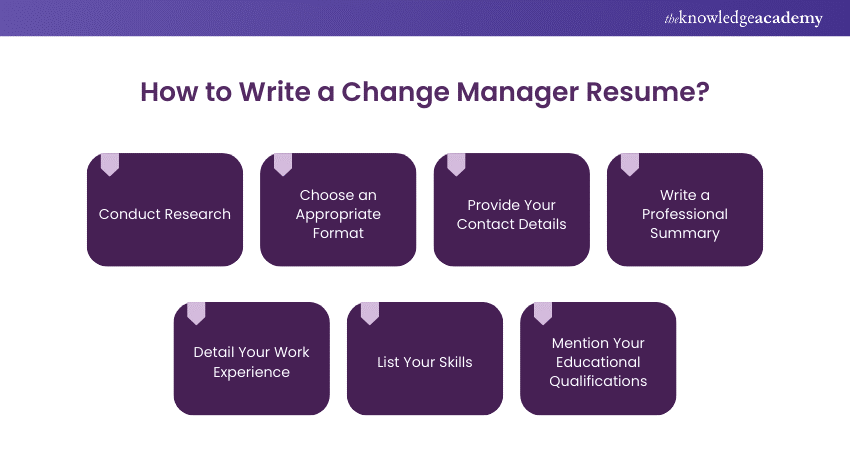We may not have the course you’re looking for. If you enquire or give us a call on +46 850282424 and speak to our training experts, we may still be able to help with your training requirements.
Training Outcomes Within Your Budget!
We ensure quality, budget-alignment, and timely delivery by our expert instructors.

Creating an exceptional Change Management Resume is essential for showcasing your expertise in guiding organisations through transitions. Whether you're an experienced professional or a beginner, this blog offers best practices to help your resume stand out. We cover everything from structuring your resume to highlighting your key skills and accomplishments.
Get ready to impress potential employers and take the next step in your Change Management career. So, let's begin writing a winning Change Management resume that truly reflects your capabilities and sets you apart from the competition.
Table of Contents
1) What is Change Management?
2) How to Write a Change Manager Resume?
3) How to add Change Management Certification to Your Resume?
4) Tips to Make Your Resume Stand Out
5) How to add Change Management Certification to Your LinkedIn?
6) Change Manager Resume Example
7) Conclusion
What is Change Management?
Change Management involves guiding an organization’s transition or transformation in its goals, processes, or technologies. Its primary aim is to develop and implement strategies that facilitate change and support people in adapting to new conditions. This encompasses various methods in the change management process to redirect or redefine the use of resources, business processes, or operational modes, thereby reshaping the organization.
Effective Change Management ensures that changes are smoothly integrated, minimizing disruption and enhancing the overall efficiency and effectiveness of the organization. By addressing the human and systemic aspects of change, and employing various change management models, it helps organizations navigate the complexities of transformation, ensuring a sustainable and successful evolution.
How to Write a Change Manager Resume?
Creating a compelling Change Manager Resume involves several key steps. Here’s a detailed list to help you craft a resume that stands out:

1) Conduct Research
Before you start writing your Change Manager resume, conduct thorough research. Understand the job role and the company you are applying to. Customise your resume to meet the requirements of the job description. Look for keywords and skills mentioned in the job posting, and make sure to incorporate them into your resume. This will help in getting past Applicant Tracking Systems (ATS).
2) Choose an Appropriate Format
Selecting the format for your resume is crucial. The most used resume formats are chronological, functional, and combination.
a) Chronological Resume: This format lists your experience in reverse chronological order, starting with your most recent job. It's ideal if you have a solid work history in Change Management.
b) Functional Resume: This focuses on your skills and experiences rather than your work history. It's suitable if you are changing careers or have gaps in your employment history.
c) Combination Resume: This combines elements of both chronological and functional resumes. It highlights your skills and experiences while also providing a detailed work history.
3) Provide Your Contact Details
Your resume should start with your contact information. Include your name, phone number, email, and LinkedIn profile if you have one. Ensure that your email address sounds professional. Avoid using nicknames or informal email addresses.
4) Write a Professional Summary
Your summary is a brief section at the top of your resume that mentions your key qualifications and career goals. It should provide a snapshot of your experience and skills, highlighting why you are the right fit for the job. Keep it concise, ideally within three to four sentences.
5) Detail Your Work Experience
In the experience section, list your previous jobs in reverse chronological order. For the position, include your job title, the name of the company, the location, and the dates you worked there. Under each job, use bullet points to highlight your key responsibilities and achievements. Be specific about your contributions and use quantifiable metrics wherever possible.
6) List Your Skills
The skills section should highlight your key competencies relevant to the role of a Change Manager. Include both hard and soft skills. Hard skills include Change Management Strategies, Project Management, Risk Assessment and Data Analysis. Soft skills include Leadership, Communication, Problem-solving and Adaptability
7) Mention Your Educational Qualifications
Include your educational background in this section. Mention your degrees in reverse chronological order, starting with the recent one. Add the name of the institution, the degree obtained, and the year of graduation. If you have any certifications relevant to Change Management, be sure to include them as well.
Gain insights into facilitating smooth organisational transitions with our Change Management Foundation – Join today!
How to add Change Management Certification to Your Resume?
To include your Change Management Certification on your resume, follow these steps:
To include your Change Management certification on your resume, follow these steps:
1) Qualifications Section:
a) List ‘Change Management (Level)’.
b) Mention the accredited training provider.
c) Include the date you obtained the certification. Note that Foundation qualifications do not expire, while Practitioner Certifications are valid for five years. After five years, you must pass a re-registration exam.
2) Resume Header:
a) Optionally, add the certification as a suffix at the top of your resume.
Tips to Make Your Resume Stand Out
Here are the tips and tricks to help you write a Change Management Resume:
a) Tailor Your Resume: Customise your resume for job application. Mention the skills and experiences that are important to the job you are applying for.
b) Use Keywords: Add keywords from the job description to help your resume pass through ATS.
c) Showcase Achievements: Focus on your accomplishments rather than just listing duties. Use metrics to quantify your achievements.
d) Keep It Concise: Aim to keep your resume within two pages. Be succinct and avoid unnecessary details.
e) Professional Layout: Use a clean and professional layout. Ensure that your resume is easy to read, with clear headings and bullet points.
f) Proofread: Thoroughly check your resume for grammatical errors. A well-polished resume reflects attention to professionalism.
Learn Change Management methods with our Managing Organisational Change Effectively Training – Join today!
Change Manager Resume Example
Here’s a template of a Change Manager Resume. You can use this as a guide to craft your own resume, ensuring you highlight your skills, experience, and qualifications effectively.
|
[Your Name] Contact Information a) Location: [Your Location] b) Email: [Your Email] c) LinkedIn: [Your LinkedIn Profile] Professional Title Change Management Professional Summary Experienced Change Manager with over [X] years of expertise in leading organisational transformations, managing change initiatives, and improving business processes. Adept at driving change strategies, enhancing employee engagement, and ensuring seamless transitions. Career Experience Senior Change Manager • [Date] – Present [Company Name] a) Spearheaded multiple change initiatives, resulting in improved operational efficiency and employee productivity. b) Developed and implemented Change Management plans, including stakeholder analysis, communication plans, and training programs. c) Collaborated with cross-functional teams to integrate Change Management practices into daily operations. d) Conducted impact assessments and provided actionable insights to senior leadership. e) Facilitated workshops and training sessions to prepare staff for organisational changes. Change Manager • [Date] – [Date] [Company Name] a) Managed end-to-end change projects, ensuring timely and within budget delivery. b) Utilised Change Management tools and methodologies to assess the impact of changes and mitigate risks. c) Coordinated with various departments to ensure alignment with change initiatives. d) Developed communication strategies to keep all stakeholders informed and engaged. e) Monitored the progress of change initiatives and adjusted plans as necessary. Assistant Change Manager • [Date] – [Date] [Company Name] a) Assisted in the development of Change Management frameworks and tools. b) Conducted change readiness assessments and supported the creation of change action plans. c) Coordinated change activities and maintained change logs and documentation. d) Supported senior Change Managers in preparing reports and presentations. e) Monitored and reported on the effectiveness of change initiatives. Skills a) Change Management Strategies b) Project Management c) Stakeholder Engagement d) Communication Planning e) Training and Development f) Impact Assessment g) Risk Mitigation h) Change Management Software (e.g., Prosci ADKAR, ChangeGear) i) Data Analysis Education a) M.Sc. in Organisational Change Management, [University Name] | [Year] b) B.Sc. in Business Administration, [Institute Name] | [Year] Certifications a) Certified Change Management Professional (CCMP), Association of Change Management Professionals (ACMP), [Year] b) [Other relevant certification], [Issuing Organisation], [Year] Languages a) [Language Name 1] b) [Language Name 2] |
Conclusion
Crafting a standout Change Management Resume involves thorough research, careful formatting, and clearly presenting your skills and experiences. You can increase your chances of securing an interview by tailoring your resume to a job application, showcasing your achievements, and keeping your information concise and well-organised. Remember to proofread your resume to ensure it is error-free and presents you in the best possible light.
Enhance your Change Management skills with our Complete Change Management Assessments Training - Join today!
Frequently Asked Questions

The 4 Ps of Change Management are Purpose, People, Process, and Performance. These elements help ensure that changes are implemented effectively, address the reasons for change, involve the right people, follow structured processes, and measure success.

Implementing Change Management starts by planning, communicating clearly with all stakeholders, and providing necessary training. Then, check the process, gather feedback, and make adjustments to ensure the change's successful adoption.

The Knowledge Academy takes global learning to new heights, offering over 30,000 online courses across 490+ locations in 220 countries. This expansive reach ensures accessibility and convenience for learners worldwide.
Alongside our diverse Online Course Catalogue, encompassing 17 major categories, we go the extra mile by providing a plethora of free educational Online Resources like News updates, Blogs, videos, webinars, and interview questions. Tailoring learning experiences further, professionals can maximise value with customisable Course Bundles of TKA.

The Knowledge Academy’s Knowledge Pass, a prepaid voucher, adds another layer of flexibility, allowing course bookings over a 12-month period. Join us on a journey where education knows no bounds.

The Knowledge Academy offers various Change Management Certification, including the Change Management Foundation Course, Change Management Practitioner Course and Risk Management for Change Training. These courses cater to different skill levels, providing comprehensive insights into the Enterprise Change Management.
Our Project Management Blogs cover a range of topics related to Change Management, offering valuable resources, best practices, and industry insights. Whether you are a beginner or looking to advance your Change Management skills, The Knowledge Academy's diverse courses and informative blogs have got you covered.
Upcoming Project Management Resources Batches & Dates
Date
 Change Management Foundation & Practitioner
Change Management Foundation & Practitioner
Mon 6th Jan 2025
Mon 13th Jan 2025
Mon 20th Jan 2025
Mon 27th Jan 2025
Mon 3rd Feb 2025
Mon 10th Feb 2025
Mon 17th Feb 2025
Mon 24th Feb 2025
Mon 3rd Mar 2025
Mon 10th Mar 2025
Mon 17th Mar 2025
Mon 24th Mar 2025
Mon 31st Mar 2025
Mon 7th Apr 2025
Mon 28th Apr 2025
Mon 12th May 2025
Mon 19th May 2025
Mon 9th Jun 2025
Mon 23rd Jun 2025
Mon 7th Jul 2025
Mon 21st Jul 2025
Mon 4th Aug 2025
Mon 18th Aug 2025
Mon 1st Sep 2025
Mon 15th Sep 2025
Mon 29th Sep 2025
Mon 13th Oct 2025
Mon 20th Oct 2025
Mon 27th Oct 2025
Mon 3rd Nov 2025
Mon 10th Nov 2025
Mon 17th Nov 2025
Mon 24th Nov 2025
Mon 1st Dec 2025
Mon 8th Dec 2025
Mon 15th Dec 2025







 Top Rated Course
Top Rated Course



 If you wish to make any changes to your course, please
If you wish to make any changes to your course, please


